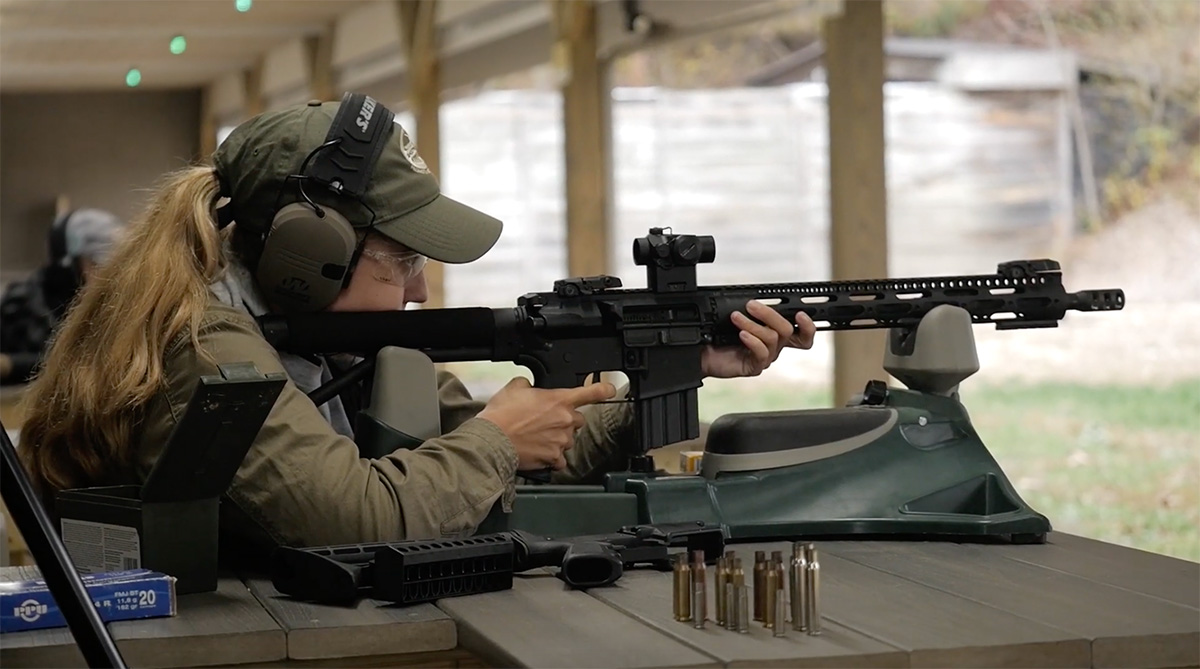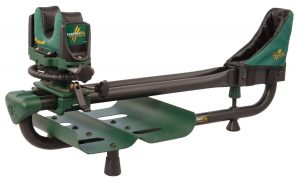
The famous author Col. Townsend Whelen was once quoted in Sports Afield magazine as saying, “Only accurate rifles are interesting.” Perhaps that sentiment is a bit overstated, especially if you’re new to the shooting sports, but the general desire to shoot more accurately and hit the intended target every time you pull the trigger is not, and it is just that desire that spawned the sport of benchrest.
What is Benchrest?
The name pretty much says it all. In benchrest, the rifle sits atop a front and rear rest. (Depending on the rules, the rests may be two separate rests or one connected rest.) The rest or rests sit atop a sturdy shooting bench or table, which explains the name “benchrest.”
Seated at the bench, with the rifle solidly positioned on the rest or rests, aids in accuracy. The hook is that everyone shooting this way has the same advantage by using a solid platform, and when the playing board is that even, successful competition is a matter of millimeters in many cases.

This is a one-piece rifle rest. Some benchrest competitions mandate that the front rest and rear be two separate pieces, while others allow rests like this one from Caldwell.
Benchrest shooting comes in many varieties these days, but one trend taking hold is to place targets at extreme distances, with many competitions holding stages at 1,000 yards and even beyond in extreme cases. At these distances, wind, temperature, bullet drop and even the rotation of the earth while the bullet is in flight are all considerations and calculation the shooter must account for before the trigger breaks and a bullet travels downrange.
Given the top competitors in the game put so much effort into making such calculations, it shouldn’t be surprising that small fortunes have been invested in crafting a winning benchrest rifle. But shooting benchrest competition certainly doesn’t have to be expensive. Indeed, there are a host of benchrest competitions with classes for novices. This allows new shooters an introduction to the sport and the chance to compete against individuals with equal experience and skills. Likewise, there are classes created around certain equipment and calibers, so there’s no need to think you need to invest thousands of dollars to begin competing, or even to win! Heck, there are even competitions tailored specifically to antique arms such as muzzleloaders, as well as carbines and military rifles from different eras.
Scoring
Various benchrest competitions are scored differently, mostly depending on the rules or sponsoring organization. Five or 10 shots at a single target may be scored solely based on the distance between the farthest hits on that target. This is competition won by “group size.” Other competitions use a more traditional bull’s-eye-type target with scoring rings. With these, the requisite number of rounds is fired and the score tallied to determine a winner. Still other benchrest competitions use both group and score to determine a winner, though there is a twist with these matches. Instead of the group size and score being combined to determine a winner, the shooters can only win either for the group size or the score. Essentially, this means you shoot once while competing in two different categories at the same time.

Yes, benchrest shooters competing for group size will have targets that look like this—and better.
Ammunition
Handloaded ammunition is most often employed in benchrest competition, for it allows the shooter to squeeze the most performance and accuracy from a rifle by tailoring the ammunition with which the rifle will shoot the best. The additional cost of reloading equipment, powders, dies and time spent at the range to develop a custom load is simply nirvana for the serious benchrest shooter and it’s not necessary for a new shooter to get started in the sport. Thanks to a growing interest in both rimfire and airgun benchrest competitions, you have plenty of low cost, factory ammunition options. There’s another advantage to these competitions in that target distance makes finding a suitable practice range easier.
Getting Started
To start shooting benchrest rifle, all you’ll need is to head to your favorite shooting range with a rifle, ammunition, targets and a rifle rest. Even simple sandbags can be used as rests to begin with, so don’t be worried if you’ve been to a benchrest competition and seen some of the complex rests the high-end competitors use—and remember, they didn’t start with that equipment either! If you were to add one accessory to help make you more successful faster, a spotting scope on a tripod would be it. A spotting scope lets you see where you’ve hit right after you’ve shot, from the bench, saving trips back and forth to the target to see where you’ve hit.
Whether you have a mentor or loved one with all of the bells and whistles of a trophy-winning benchrest setup or you simply want to improve your shooting technique, head to the rifle range. Benchrest is an excellent sport with which to perfect trigger control, sight alignment and breathing, and if you stick with it and move on to handload and compete more seriously, you’ll gain an intimate knowledge of how a rifle and ammunition can work together. Either way, you’ll quickly gain a new level of confidence and discover both your limits and those of your equipment. Most of all, though, you will surely have fun and, as it is with all shooting sports, you’ll find a group of people ready to help you succeed. And that, in the end, is what the shooting sports are all about.
Benchrest Resources
- United States Benchrest
- International Benchrest Shooters
- National Benchrest Shooters Association
- IR50/50
- American Rimfire Association
- Rimfire Benchrest Association
- World Rimfire and Air Rifle Benchrest Association
- Ultimate Benchrest Shooting
- Professional Shooting League
- United States Air Rifle Benchrest





